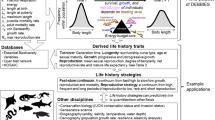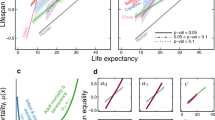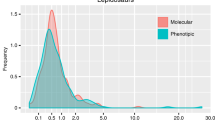Abstract
Animals exhibit an extraordinary diversity of life history strategies. These realized combinations of survival, development and reproduction are predicted to be constrained by physiological limitations and by trade-offs in resource allocation. However, our understanding of these patterns is restricted to a few taxonomic groups. Using demographic data from 121 species, ranging from humans to sponges, we test whether such trade-offs universally shape animal life history strategies. We show that, after accounting for body mass and phylogenetic relatedness, 71% of the variation in animal life history strategies can be explained by life history traits associated with the fast–slow continuum (pace of life) and with a second axis defined by the distribution of age-specific mortality hazards and the spread of reproduction. While we found that life history strategies are associated with metabolic rate and ecological modes of life, surprisingly similar life history strategies can be found across the phylogenetic and physiological diversity of animals.
This is a preview of subscription content, access via your institution
Access options
Access Nature and 54 other Nature Portfolio journals
Get Nature+, our best-value online-access subscription
$29.99 / 30 days
cancel any time
Subscribe to this journal
Receive 12 digital issues and online access to articles
$119.00 per year
only $9.92 per issue
Buy this article
- Purchase on Springer Link
- Instant access to full article PDF
Prices may be subject to local taxes which are calculated during checkout




Similar content being viewed by others
Data availability
All demography data are available from the COMADRE database (http://www.compadre-db.org). Additional data are available in Supplementary Data.
Code availability
The code used to generate the analysis can be accessed on Github: https://github.com/healyke/Healy_et_al_2019_Animal_Life_History.
References
Vrtílek, M., Žák, J., Pšenička, M. & Reichard, M. Extremely rapid maturation of a wild African annual fish. Curr. Biol. 28, R822–R824 (2018).
Nielsen, J. et al. Eye lens radiocarbon reveals centuries of longevity in the Greenland shark (Somniosus microcephalus). Science 353, 702–704 (2016).
Stearns, S. C. Life history evolution: successes, limitations, and prospects. Naturwissenschaften 87, 476–486 (2000).
Stearns, S. C. The influence of size and phylogeny on patterns of covariation among life-history traits in the mammals. Oikos 41, 173–187 (1983).
De Magalhaes, J. & Costa, J. A database of vertebrate longevity records and their relation to other life‐history traits. J. Evol. Biol. 22, 1770–1774 (2009).
Brusca, R., Moore, W. & Shuster, S. Invertebrates 3rd edn (Sinauer Associates, 2016).
Gross, M. R. Disruptive selection for alternative life histories in salmon. Nature 313, 47 (1985).
Hughes, P. W. Between semelparity and iteroparity: empirical evidence for a continuum of modes of parity. Ecol. Evol. 7, 8232–8261 (2017).
Capellini, I., Baker, J., Allen, W. L., Street, S. E. & Venditti, C. The role of life history traits in mammalian invasion success. Ecol. Lett. 18, 1099–1107 (2015).
Jones, O. R. et al. Diversity of ageing across the tree of life. Nature 505, 169–173 (2014).
Law, R. Optimal life histories under age-specific predation. Am. Nat. 114, 399–417 (1979).
Stearns, S. C. The Evolution of Life Histories (Oxford Univ. Press, 1992)
Bielby, J. et al. The fast–slow continuum in mammalian life history: an empirical reevaluation. Am. Nat. 169, 748–757 (2007).
Salguero-Gómez, R. et al. Fast–slow continuum and reproductive strategies structure plant life-history variation worldwide. Proc. Natl Acad. Sci. USA 113, 230–235 (2016).
Bauwens, D. & Diaz-Uriarte, R. Covariation of life-history traits in lacertid lizards: a comparative study. Am. Nat. 149, 91–111 (1997).
Paniw, M., Ozgul, A. & Salguero-Gómez Interactive life-history traits predict sensitivity of plants and animals to temporal autocorrelation. Ecol. Lett. 21, 275–286 (2017).
Bischof, R. et al. Regulated hunting re-shapes the life history of brown bears. Nat. Ecol. Evol. 2, 116 (2018).
Winemiller, K. O., Fitzgerald, D. B., Bower, L. M. & Pianka, E. R. Functional traits, convergent evolution, and periodic tables of niches. Ecol. Lett. 18, 737–751 (2015).
Gaillard, J.-M. et al. An analysis of demographic tactics in birds and mammals. Oikos 56, 59–76 (1989).
Salguero‐Gómez, R. et al. COMADRE: a global data base of animal demography. J. Anim. Ecol. 85, 371–384 (2016).
Gaillard, J.-M. et al. Generation time: a reliable metric to measure life-history variation among mammalian populations. Am. Nat. 166, 119–123 (2005).
Oli, M. K. The fast–slow continuum and mammalian life-history patterns: an empirical evaluation. Basic Appl. Ecol. 5, 449–463 (2004).
Dobson, F. S. & Oli, M. K. Fast and slow life histories of mammals. Ecoscience 14, 292–297 (2007).
Read, A. F. & Harvey, P. H. Life history differences among the eutherian radiations. J. Zool. 219, 329–353 (1989).
Ricklefs, R. E. Life-history connections to rates of aging in terrestrial vertebrates. Proc. Natl Acad. Sci. USA 107, 10314–10319 (2010).
Brown, J. H., Hall, C. A. S. & Sibly, R. M. Equal fitness paradigm explained by a trade-off between generation time and energy production rate. Nat. Ecol. Evol. 2, 262–268 (2018).
Colchero, F. et al. The emergence of longevous populations. Proc. Natl Acad. Sci. USA 113, E7681–E7690 (2016).
Wrycza, T. F., Missov, T. I. & Baudisch, A. Quantifying the shape of aging. PLoS ONE 10, e0119163 (2015).
Cole, L. C. The population consequences of life history phenomena. Q. Rev. Biol. 29, 103–137 (1954).
Charnov, E. L. & Schaffer, W. M. Life-history consequences of natural selection: Cole’s result revisited. Am. Nat. 107, 791–793 (1973).
Martin, J. G. & Festa‐Bianchet, M. Age‐independent and age‐dependent decreases in reproduction of females. Ecol. Lett. 14, 576–581 (2011).
Huber, S. & Fieder, M. Evidence for a maximum ‘shelf-life’ of oocytes in mammals suggests that human menopause may be an implication of meiotic arrest. Sci. Rep. 8, 14099 (2018).
Lahdenperä, M., Mar, K. U. & Lummaa, V. Reproductive cessation and post-reproductive lifespan in Asian elephants and pre-industrial humans. Front. Zool. 11, 54 (2014).
Congdon, J. D. et al. Testing hypotheses of aging in long-lived painted turtles (Chrysemys picta). Exp. Gerontol. 38, 765–772 (2003).
Congdon, J., Nagle, R., Kinney, O. & van Loben Sels, R. Hypotheses of aging in a long-lived vertebrate, Blanding’s turtle (Emydoidea blandingii). Exp. Gerontol. 36, 813–827 (2001).
Vaupel, J. W., Baudisch, A., Dölling, M., Roach, D. A. & Gampe, J. The case for negative senescence. Theor. Popul. Biol. 65, 339–351 (2004).
Barneche, D. R., Robertson, D. R., White, C. R. & Marshall, D. J. Fish reproductive-energy output increases disproportionately with body size. Science 360, 642–645 (2018).
Williams, G. C. Pleiotropy, natural selection, and the evolution of senescence. Evolution 11, 398–411 (1957).
Healy, K. et al. Ecology and mode-of-life explain lifespan variation in birds and mammals. Proc. R. Soc. Lond. B 281, 20140298 (2014).
Bjørkvoll, E. et al. Stochastic population dynamics and life-history variation in marine fish species. Am. Nat. 180, 372–387 (2012).
Nakayama, S., Rapp, T. & Arlinghaus, R. Fast–slow life history is correlated with individual differences in movements and prey selection in an aquatic predator in the wild. J. Anim. Ecol. 86, 192–201 (2017).
Brown, J. H., Gillooly, J. F., Allen, A. P., Savage, V. M. & West, G. B. Toward a metabolic theory of ecology. Ecology 85, 1771–1789 (2004).
Reznick, D. N., Bryant, M. J., Roff, D., Ghalambor, C. K. & Ghalambor, D. E. Effect of extrinsic mortality on the evolution of senescence in guppies. Nature 431, 1095–1099 (2004).
Burns, J. H. et al. Empirical tests of life-history evolution theory using phylogenetic analysis of plant demography. J. Ecol. 98, 334–344 (2010).
Auer, S. K., Dick, C. A., Metcalfe, N. B. & Reznick, D. N. Metabolic rate evolves rapidly and in parallel with the pace of life history. Nat. Commun. 9, 14 (2018).
Baker, T. R. et al. Fast demographic traits promote high diversification rates of Amazonian trees. Ecol. Lett. 17, 527–536 (2014).
Sepp, T., McGraw, K. J., Kaasik, A. & Giraudeau, M. A review of urban impacts on avian life‐history evolution: does city living lead to slower pace of life? Glob. Change Biol. 24, 1452–1469 (2018).
Collett, R. A., Baker, A. M. & Fisher, D. O. Prey productivity and predictability drive different axes of life-history variation in carnivorous marsupials. Proc. R. Soc. Lond. B 285, https://doi.org/10.1098/rspb.2018.1291 (2018).
Allen, W. L., Street, S. E. & Capellini, I. Fast life history traits promote invasion success in amphibians and reptiles. Ecol. Lett. 20, 222–230 (2017).
Salguero-Gómez, R. Implications of clonality for ageing research. Evol. Ecol. 32, 9–28 (2018).
Stott, I., Hodgson, D. J. & Townley, S. popdemo: an R package for population demography using projection matrix analysis. Methods Ecol. Evol. 3, 797–802 (2012).
Keyfitz, K. & Flieger, W. World Population: An Analysis of Vital Data (Univ. of Chicago Press, 1968).
Keyfitz, N. & Flieger, W. Population: Facts and Methods of Demography (W. H. Freeman, 1971).
Keyfitz, N. & Flieger, W. World Population Growth and Aging: Demographic Trends in the Late Twentieth Century (Univ. of Chicago Press, 1990).
Myhrvold, N. P. et al. An amniote life‐history database to perform comparative analyses with birds, mammals, and reptiles. Ecology 96, 3109–3109 (2015).
Froese, R. & Pauly, D. (eds) FishBase (World wide web electronic publication, accessed 13 June 2016); http://www.fishbase.org.
White, C. R. & Seymour, R. S. Mammalian basal metabolic rate is proportional to body mass2/3. Proc. Natl Acad. Sci. USA 100, 4046–4049 (2003).
White, C. R., Phillips, N. F. & Seymour, R. S. The scaling and temperature dependence of vertebrate metabolism. Biol. Lett. 2, 125–127 (2006).
McNab, B. K. Ecological factors affect the level and scaling of avian BMR. Comp. Biochem. Physiol. A 152, 22–45 (2009).
Killen, S. S. et al. Ecological influences and morphological correlates of resting and maximal metabolic rates across teleost fish species. Am. Nat. 187, 592–606 (2016).
Genoud, M., Isler, K. & Martin, R. D. Comparative analyses of basal rate of metabolism in mammals: data selection does matter. Biol. Rev. 93, 404–438 (2018).
Ultsch, G. R. Metabolic scaling in turtles. Comp. Biochem. Physiol. A 164, 590–597 (2013).
Fristoe, T. S. et al. Metabolic heat production and thermal conductance are mass-independent adaptations to thermal environment in birds and mammals. Proc. Natl Acad. Sci. USA 112, 15934–15939 (2015).
The IUCN Red List of Threatened Species (IUCN, 2019); http://www.iucnredlist.org.
Hinchliff, C. E. et al. Synthesis of phylogeny and taxonomy into a comprehensive tree of life. Proc. Natl Acad. Sci. USA 112, 12764–12769 (2015).
Hadfield, J. D. MCMC methods for multi-response generalized linear mixed models: the MCMCglmm R package. J. Stat. Softw. 33, 1–22 (2010).
Guillerme, T. & Healy, K. mulTree: A Package for Running MCMCglmm Analysis on Multiple Trees (Zenodo, 2014); https://doi.org/10.5281/zenodo.12902
Healy, K. Eusociality but not fossoriality drives longevity in small mammals. Proc. R. Soc. Lond. B 282, 20142917 (2015).
Salguero-Gomez, R. & Plotkin, J. B. Matrix dimensions bias demographic inferences: implications for comparative plant demography. Am. Nat. 176, 710–722 (2010).
Dinno, A. paran: Horn’s Test of Principal Components/Factors R package v.1.5.2 (CRAN, 2012); https://cran.r-project.org/web/packages/paran/index.html.
Jackson, A. L., Inger, R., Parnell, A. C. & Bearhop, S. Comparing isotopic niche widths among and within communities: SIBER–Stable Isotope Bayesian Ellipses in R. J. Anim. Ecol. 80, 595–602 (2011).
Acknowledgements
This publication has emanated from research conducted with the financial support of Science Foundation Ireland (SFI grant no. 15/ERCD/2803 to Y.M.B.), the Natural Environment Research Council (grant no. NE/M018458/1 to R.S.-G.) and the Australian Research Council (grant no. DE140100505 to R.S.-G.). O.R.J. is supported by the Danish Council for Independent Research (grant no. 6108-00467B). We thank the Laboratory of Evolutionary Biodemography at the Max Planck Institute for Demographic Research for support, development and curation of the COMADRE Animal Matrix Database.
Author information
Authors and Affiliations
Contributions
K.H. designed and conducted the analysis, collated body size, mode of life, metabolic rate and phylogenetic data and wrote the manuscript. T.H.G.E contributed additional human demography data. O.R.J. provided additional code used in the analysis. Y.M.B. and R.S.-G. designed the research. All authors contributed to analysis, design, discussion and interpretation of the results and writing of the manuscript.
Corresponding author
Ethics declarations
Competing interests
The authors declare no competing interests.
Additional information
Publisher’s note: Springer Nature remains neutral with regard to jurisdictional claims in published maps and institutional affiliations.
Supplementary information
Supplementary Information
Supplementary Methods, Supplementary Figs. 1–3, and Supplementary Tables 1–5
Supplementary Data 1
Species from the COMADRE Animal Matrix Database that meet the selection criteria and corresponding data
Rights and permissions
About this article
Cite this article
Healy, K., Ezard, T.H.G., Jones, O.R. et al. Animal life history is shaped by the pace of life and the distribution of age-specific mortality and reproduction. Nat Ecol Evol 3, 1217–1224 (2019). https://doi.org/10.1038/s41559-019-0938-7
Received:
Accepted:
Published:
Issue Date:
DOI: https://doi.org/10.1038/s41559-019-0938-7
This article is cited by
-
Meta-analysis shows no consistent evidence for senescence in ejaculate traits across animals
Nature Communications (2024)
-
Contemporary reproductive patterns of Snake River Oncorhynchus nerka in Pettit Lake
Conservation Genetics (2024)
-
Towards establishing a fungal economics spectrum in soil saprobic fungi
Nature Communications (2024)
-
Exploratory preferences explain the human fascination for imaginary worlds in fictional stories
Scientific Reports (2023)
-
Correlated evolution of social organization and lifespan in mammals
Nature Communications (2023)



